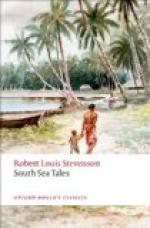At the upper end of the inlet, its low, cliffy lining sinks, at both sides, into a beach. A copra warehouse stands in the shadow of the shoreside trees, flitted about for ever by a clan of dwarfish swallows; and a line of rails on a high wooden staging bends back into the mouth of the valley. Walking on this, the new-landed traveller becomes aware of a broad fresh-water lagoon (one arm of which he crosses), and beyond, of a grove of noble palms, sheltering the house of the trader, Mr. Keane. Overhead, the cocos join in a continuous and lofty roof; blackbirds are heard lustily singing; the island cock springs his jubilant rattle and airs his golden plumage; cow-bells sound far and near in the grove; and when you sit in the broad verandah, lulled by this symphony, you may say to yourself, if you are able: ‘Better fifty years of Europe . . .’ Farther on, the floor of the valley is flat and green, and dotted here and there with stripling coco-palms. Through the midst, with many changes of music, the river trots and brawls; and along its course, where we should look for willows, puraos grow in clusters, and make shadowy pools after an angler’s heart. A vale more rich and peaceful, sweeter air, a sweeter voice of rural sounds, I have found nowhere. One circumstance alone might strike the experienced: here is a convenient beach, deep soil, good water, and yet nowhere any paepaes, nowhere any trace of island habitation.
It is but a few years since this valley was a place choked with jungle, the debatable land and battle-ground of cannibals. Two clans laid claim to it—neither could substantiate the claim, and the roads lay desert, or were only visited by men in arms. It is for this very reason that it wears now so smiling an appearance: cleared, planted, built upon, supplied with railways, boat-houses, and bath-houses. For, being no man’s land, it was the more readily ceded to a stranger. The stranger was Captain John Hart: Ima Hati, ‘Broken-arm,’ the natives call him, because when he first visited the islands his arm was in a sling. Captain Hart, a man of English birth, but an American subject, had conceived the idea of cotton culture in the Marquesas during the American War, and was at first rewarded with success. His plantation at Anaho was highly productive; island cotton fetched a high price, and the natives used to debate which was the stronger power, Ima Hati or the French: deciding in favour of the captain, because, though the French had the most ships, he had the more money.
He marked Taahauku for a suitable site, acquired it, and offered the superintendence to Mr. Robert Stewart, a Fifeshire man, already some time in the islands, who had just been ruined by a war on Tauata. Mr. Stewart was somewhat averse to the adventure, having some acquaintance with Atuona and its notorious chieftain, Moipu. He had once landed there, he told me, about dusk, and found the remains of a man and woman partly eaten. On his starting and




